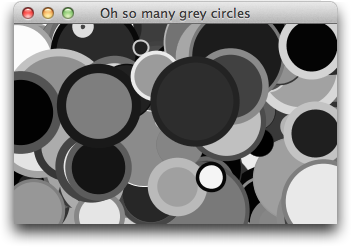Quil looked up in shock to see Bigelow floating high in the clouds, his balloons rustling merrily in the wind. He gruffed to her from above, "This truly is a party!". Image after image, vista after vista, passed furry Bige's wide-open eyes. A deep underlying beauty unfolded before him. A flock of bezier gulls whistled past. Beneath his dangling paws a distant shepherd called his scribbly sheep in for re-sketching. Goading him from the distance, wooden letters of so many different fonts mocked PERLIN-WOULD from the hilltops.
This truly was an amazing place. Here, dreams and reality had been drawn together - all in one Process. "_Why would I ever leave?" he barked with joy! _Why indeed!
In one hand Quil holds Processing, a carefully crafted API for making drawing and animation extremely easy to get your biscuit-loving chops around. In the other she clutches Clojure, an interlocking suite of exquisite language abstractions forged by an army of hammocks and delicately wrapped in flowing silky parens of un-braided joy.
In one swift, skilled motion, Quil throws them both high into the air. In a dusty cloud of pixels, they bond instantly and fly off into the distance painting their way with immutable trails of brilliant colour. Moments later, you see them swiftly return and hover nearby. Your very own ride to Perlinwould awaits. Summon the winds and ride well, my friend.
Quil works with Clojure 1.10 and ClojureScript 1.10.x.
Create sample project using Quil lein template:
lein new quil hello-quilThen go to hello-quil/src/hello-quil/core.clj file and run it!
If you like adding libraries manually - you simply need to add Quil as a dependency to project.clj:
[quil "3.1.0"]Then to pull in all of Quil's silky goodness, just add the following to your ns declaration:
(:require [quil.core :as q])For more detailed instructions head over to the wiki.
Using Quil is as easy as eating chocolate digestives. You just need to grok three basic concepts:
- The Setup fn
- The Draw fn
- The Sketch
If setup and draw are hard working artistic gladiators, sketch is the arena in which they battle for the glory of art. However, they don't actually fight each other - they work as a team - relentlessly spilling colour all over the arena sands. The crowds roar for messy fight.
setup lays all the groundwork and is called only once at the start. draw, on the other hand, is called immediately after setup has completed, and then repeatedly until you summon it to stop. When you create a sketch and name your setup and draw fns, the fun automatically starts.
A simple example is called for:
(ns for-the-glory-of-art
(:require [quil.core :as q]))
(defn setup []
(q/frame-rate 1) ;; Set framerate to 1 FPS
(q/background 200)) ;; Set the background colour to
;; a nice shade of grey.
(defn draw []
(q/stroke (q/random 255)) ;; Set the stroke colour to a random grey
(q/stroke-weight (q/random 10)) ;; Set the stroke thickness randomly
(q/fill (q/random 255)) ;; Set the fill colour to a random grey
(let [diam (q/random 100) ;; Set the diameter to a value between 0 and 100
x (q/random (q/width)) ;; Set the x coord randomly within the sketch
y (q/random (q/height))] ;; Set the y coord randomly within the sketch
(q/ellipse x y diam diam))) ;; Draw a circle at x y with the correct diameter
(q/defsketch example ;; Define a new sketch named example
:title "Oh so many grey circles" ;; Set the title of the sketch
:settings #(q/smooth 2) ;; Turn on anti-aliasing
:setup setup ;; Specify the setup fn
:draw draw ;; Specify the draw fn
:size [323 200]) ;; You struggle to beat the golden ratioFeast your eyes on this beauty.
You're witnessing setup, draw and sketch working in complete harmony. See how setup turns on anti-aliasing, sets the framerate to 1 FPS and sets the background colour to a nice shade of grey. draw then kicks into action. It chooses random stroke, fill colours as well as a random stroke weight (thickness of the pen). It then chooses some random coordinates and circle size and draws an ellipse. An ellipse with the same height and width is a circle. Finally defsketch a convenience macro around sketch ties everything together, specifies a title and size and starts things running. Don't just watch it though, start modifying it to see immediate effects. Go to town.
Quil supports ClojureScript! Check wiki article for more info.
For up-to-date documentation please check API page on quil.info.
When getting started with Quil, it's always useful to have the Cheatsheet handy. It may be a little bit out-dated but still contains most functions.
If you're new to Processing and graphics programming in general, the Processing.org Learning Pages are an excellent primer and will get you started in no time.
Check Quil wiki for more documentation.
Quil comes chock-packed full of examples covering most of the available API. Many of them have been translated from the excellent book "Generative Art" by Matt Pearson, with kind permission from the author.
Head over to the Gen Art Examples Page. Instructions of how to run examples you can find in README in Quil examples repo.
Also check out awesome gallery of sketches contributed by community members: http://quil.info/examples
Quil provides support for the standard Processing API - currently version 3.3.7 of Processing and 1.6.6 of Processing.js. The majority of Processing methods have an equivalent Quil fn. Typically, camelCased methods have been converted to hyphenated-versions.
You can ask questions, get support on our mailing list:
https://groups.google.com/forum/?fromgroups#!forum/clj-processing
There is also a small number of people that hang out in #quil on freenode. New artworks are show-cased on the @quilist Twitter account: http://twitter.com/quilist
Modifying Quil and testing changes is pretty simple. First run lein compile to compile some java classes. Then depending on whether you want to test Clojure or ClojureScript:
- If use emacs+cider, open
dev/sample.cljand evaluate. - Alternatively run
lein run -m samplewhich runs the sketch fromdev/sample.clj.
- Run
lein with-profile cljs-testing cljsbuild auto developmentwhich compiles Quil to JS and also compiles a sample sketch indev/sample.cljs. - Run
python -m SimpleHTTPServer(Python 2) orpython -m http.server(Python 3) to start local static server. Open http://localhost:8000/dev/index.html. - Alternatively, if you don't have python, open
dev/index.htmlpage from browser. It should work as well.
In ClojureScript all changes to cljs files (e.g. dev/sample.cljs or src/cljs/...) will be automatically recompiled. You just need to refresh the page.
Distributed under the Eclipse Public License either version 1.0 or (at your option) any later version.
The official Processing.org's jars, used as dependencies, are distributed under LGPL and their code can be found on http://processing.org/
See list of contributors.


